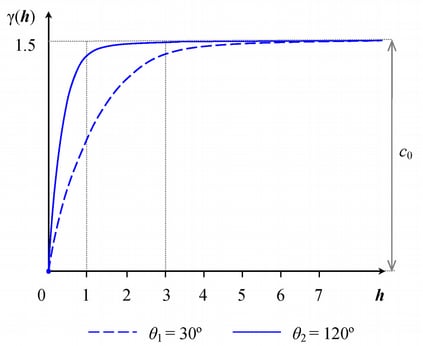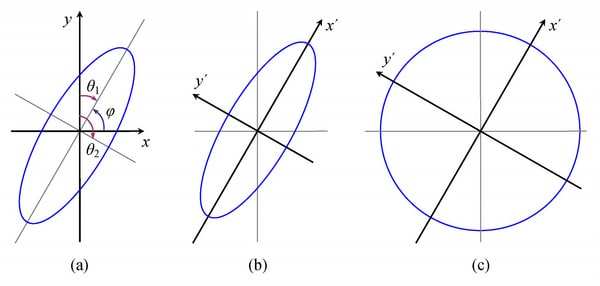| The KRIGE2D Procedure |
Geometric Anisotropy
Geometric anisotropy is the simplest type of anisotropy. It occurs when the same sill (or scale) parameter  is present in all directions but the range
is present in all directions but the range  changes with direction. Note also that in geometric anisotropy the same covariance form (or forms, if you use a nested model) is present in all directions.
changes with direction. Note also that in geometric anisotropy the same covariance form (or forms, if you use a nested model) is present in all directions.
Therefore, there is a single sill in geometric anisotropy, but the semivariogram reaches the sill in a shorter lag distance along a certain direction. This is illustrated in Figure 46.12, where an anisotropic exponential semivariogram is plotted. Assume that the two curves displayed in this figure have the same sill  and are generated using the ranges
and are generated using the ranges  in the direction
in the direction  (effective range is
(effective range is  ) and
) and  in the direction
in the direction  (effective range is
(effective range is  ).
).
As you can see from the figure, the ratio of the shorter to longer range is  . The anisotropy factor
. The anisotropy factor  is the value to use in the RATIO= parameter in the MODEL statement in PROC KRIGE2D. Note that
is the value to use in the RATIO= parameter in the MODEL statement in PROC KRIGE2D. Note that  for modeling geometric anisotropy. In fact, isotropy is a partial case of geometric anisotropy for which
for modeling geometric anisotropy. In fact, isotropy is a partial case of geometric anisotropy for which  and
and  .
.


The values of the RANGE= and ANGLE= parameters in the MODEL statement in PROC KRIGE2D are set based on the major anisotropy axis characteristics. Specifically, the RANGE= parameter is the value of the major axis range  , and the ANGLE= parameter is the angle
, and the ANGLE= parameter is the angle  of the major axis measured clockwise from north (angles measured in this way are also known as azimuths). You can then specify the following MODEL statement in PROC KRIGE2D to approximate the covariance structure:
of the major axis measured clockwise from north (angles measured in this way are also known as azimuths). You can then specify the following MODEL statement in PROC KRIGE2D to approximate the covariance structure:
MODEL FORM=EXP RANGE=3 SCALE=1.5 ANGLE=30 RATIO=0.3333;
If you use a nested model, provide the type for each one of the nested structures with the FORM= option, and assign the individual SCALE= parameters so that they add up to the total sill (include in the sum the nugget effect, if present). In the typical case, all of your nested structures have the same anisotropy axes. This means that you specify the same ANGLE= parameter value for all structures. Each structure likely has its own values for the RANGE= and RATIO= parameters depending on the degree of its contribution to the nested model.
The terminology associated with geometric anisotropy is that of ellipses. To see how this comes about, consider the following hypothetical set of calculations. Let { } be a geometrically anisotropic process, and assume there are sufficient data points to calculate an experimental semivariogram at a large number of angle classes
} be a geometrically anisotropic process, and assume there are sufficient data points to calculate an experimental semivariogram at a large number of angle classes  }. At each of these angles
}. At each of these angles  , the experimental semivariogram is plotted and the range
, the experimental semivariogram is plotted and the range  is recorded. A diagram in polar coordinates
is recorded. A diagram in polar coordinates  yields an ellipse with the major axis
yields an ellipse with the major axis  in the direction of the largest
in the direction of the largest  and the minor axis
and the minor axis  perpendicular to it. For the example in Figure 46.12, the ellipse is shown in Figure 46.13(a). Its major axis has size
perpendicular to it. For the example in Figure 46.12, the ellipse is shown in Figure 46.13(a). Its major axis has size  situated at angle
situated at angle  clockwise from north, and the minor axis has size
clockwise from north, and the minor axis has size  oriented at angle
oriented at angle  clockwise from north.
clockwise from north.
The KRIGE2D procedure handles geometric anisotropy by applying a reversible transformation in two steps that converts geometric anisotropy into isotropic conditions.
The first step is to align your coordinates axes with the anisotropy ellipse axes. Specifically, you choose to rotate by an angle  the standard Cartesian orientation of the
the standard Cartesian orientation of the  coordinates system shown in Figure 46.13(a) so that the
coordinates system shown in Figure 46.13(a) so that the  axis coincides with the ellipse minor axis. The rotation result is illustrated in Figure 46.13(b). The second step is to elongate the minor axis so its length equals that of the major axis of the ellipse. You can see the result in Figure 46.13(c). The computational details are shown in the following.
axis coincides with the ellipse minor axis. The rotation result is illustrated in Figure 46.13(b). The second step is to elongate the minor axis so its length equals that of the major axis of the ellipse. You can see the result in Figure 46.13(c). The computational details are shown in the following.

The transformation angle  is measured in standard Cartesian orientation counterclockwise from the
is measured in standard Cartesian orientation counterclockwise from the  axis (east). If the major axis azimuth is
axis (east). If the major axis azimuth is  , then the Cartesian system of
, then the Cartesian system of  needs to be rotated by
needs to be rotated by  so that the
so that the  axis can coincide with the ellipse minor axis; see Figure 46.13(a). Let us call the ellipse major axis
axis can coincide with the ellipse minor axis; see Figure 46.13(a). Let us call the ellipse major axis  and the minor axis
and the minor axis  . The transformation that converts any coordinates in the
. The transformation that converts any coordinates in the  system into
system into  coordinates in terms of
coordinates in terms of  is given by the matrix:
is given by the matrix:
 |
The elongation of the minor axis in the second step is performed with the matrix:
 |
Note that these two steps are sequential and their order cannot be reversed. For any point pair  and
and  with respective coordinates
with respective coordinates  and
and  in the
in the  axes, their distance is given by:
axes, their distance is given by:
 |
where the distance components  and
and  . Based on the previous, the corresponding distances
. Based on the previous, the corresponding distances  and
and  in the
in the  coordinates system are given by the vector:
coordinates system are given by the vector:
 |
The transformed interpair distance is then:
 |
As a result, the original anisotropic semivariogram in Figure 46.12 that was a function  of both
of both  and
and  is then transformed to an equivalent function
is then transformed to an equivalent function  only of
only of  :
:
 |
This single isotropic semivariogram  is then used for kriging purposes.
is then used for kriging purposes.
Note that the two steps used by PROC KRIGE2D in the previous analysis can be performed in a different manner, as well. For instance, you might equivalently choose to rotate the  Cartesian coordinates so that the
Cartesian coordinates so that the  axis coincides with the ellipse major axis, rather than with the minor axis as was shown earlier. Also, you might prefer to compress the major axis rather than elongating the short one. In any case, you need to perform the appropriate computations for the transformation of your choice.
axis coincides with the ellipse major axis, rather than with the minor axis as was shown earlier. Also, you might prefer to compress the major axis rather than elongating the short one. In any case, you need to perform the appropriate computations for the transformation of your choice.
Copyright © 2009 by SAS Institute Inc., Cary, NC, USA. All rights reserved.